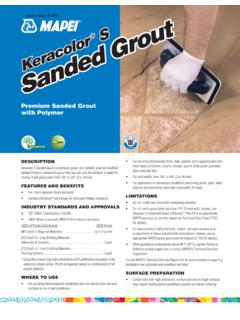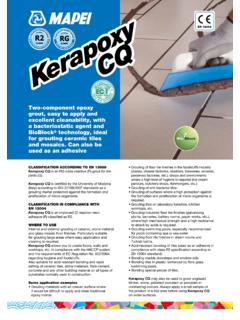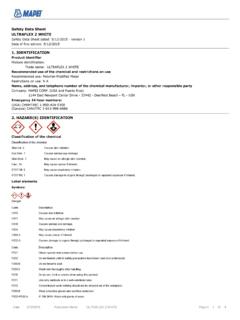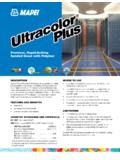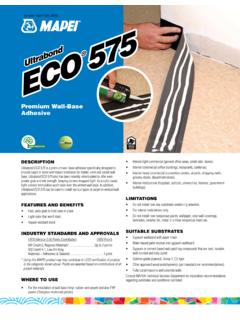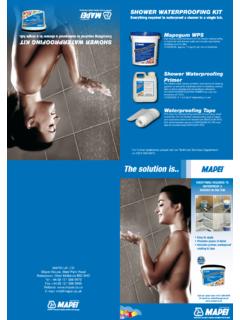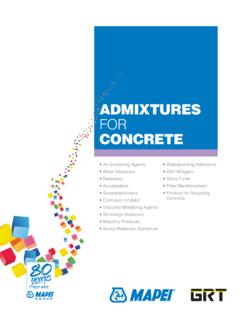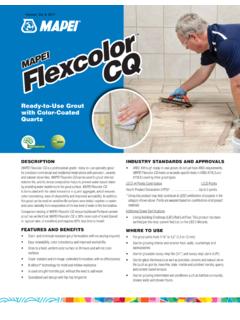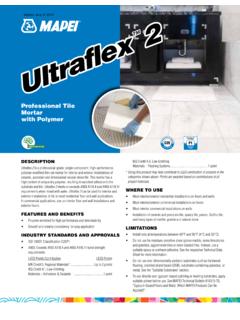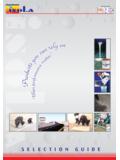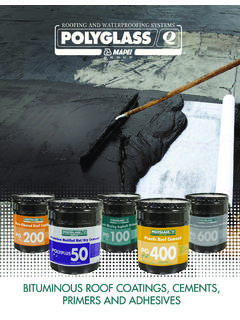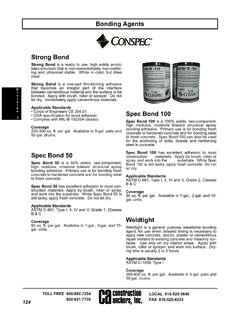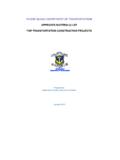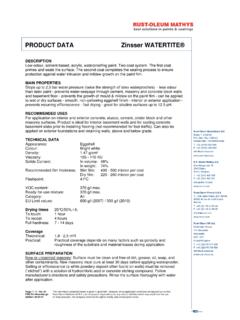Transcription of Fast-Setting, Polymer-Modified, Cement-Based Patching …
1 planipatch planipatch Fast-Setting, Polymer-Modified, Cement-Based Patching CompoundDESCRIPTIONP lanipatch is an ultra fast-drying, self-curing, polymer-modified, Cement-Based Patching compound that rapidly develops high compressive strength. When planipatch is mixed with planipatch Plus, the planipatch Plus System can be used as an embossing leveler or as a patch to fill voids over properly prepared vinyl sheet goods, vinyl composition tile (VCT) and cement terrazzo before the direct glue-down installation of floor AND BENEFITS Fast-setting Polymer-modified Easy to applyINDUSTRY STANDARDS AND APPROVALS LEED (Version ) Points Contribution LEED PointsMR Credit 5, Regional Materials*.
2 Up to 2 points IEQ Credit , Low-Emitting Materials Adhesives & Sealants ..1 point* Using this MAPEI product may help contribute to LEED certification of projects in the categories shown above. Points are awarded based on contributions of all project materials. WHERE TO USE For skimcoating unfinished, rough-textured concrete and approved wood underlayments For filling minor voids, holes and cracks in concrete and approved wood underlayments Mix planipatch with planipatch Plus and use as an embossing leveler or as a patch to fill voids over properly prepared existing cement terrazzo, ceramic tile, VCT, or non-cushioned, fully adhered residential sheet vinyl flooring, cutback and carpet adhesive residues.
3 Interior residential (rental apartments, condominiums, homes) Interior commercial (office buildings, hotel rooms and hallways, restaurants, cafeterias) Interior heavy commercial (hotel lobbies, convention centers, airports, shopping malls, grocery stores, department stores) Interior institutional (hospitals, schools, universities, libraries, government buildings)See Limitations section Do not install over substrates containing asbestos. Do not use as a final wear surface. Use only when the substrate and ambient temperatures are between 50 F and 100 F (10 C and 38 C). For interior installations only Do not apply over self-stick tile, presswood, particleboard, flakeboard or similar types of dimensionally unstable substrates.
4 Do not install when the moisture vapor emission rate (MVER) exceeds 8 lbs. per 1,000 sq. ft. (3,63 kg per 92,9 m2) per 24 hours, when using the Photo shows mixture of planipatch and planipatch PlusTMPlanipatch planipatch anhydrous calcium chloride test (ASTM F1869). Do not exceed the flooring manufacturer s recommendations for MVER. When MVER is above 5 lbs. per 1,000 sq. ft. (2,27 kg per 92,9 m2) per 24 hours, planipatch Plus is recommended for optimum performance. Do not install when the relative humidity (RH) exceeds 85%, when using the in-situ probe method (ASTM F2170). Do not exceed the flooring manufacturer s recommendations for RH.
5 Do not use to fill existing expansion control joints. When leveling large areas, use as a thin application only. Refer to Technical Data Sheets (TDSs) at for use of self-leveling products. SUITABLE SUBSTRATESWhen mixed with water or diluted planipatch Plus Concrete APA or CANPLY Group 1 exterior-glue plywood Other approved wood underlayments (per flooring manufacturer s recommendations)When mixed with planipatch Plus (full-strength) Properly prepared cutback and carpet adhesive residue Existing, properly prepared cement terrazzo Existing, properly prepared and fully bonded ceramic tile A single layer of properly prepared, fully bonded VCT A single layer of properly prepared, fully bonded felt-backed sheet vinylConsult MAPEI s Technical Services Department for installation recommendations regarding substrates and conditions not PREPARATION All substrates must be structurally sound, dry, solid and stable.
6 Substrate should be clean and free of dust, dirt, oil, grease, paint, curing agents, concrete sealers, loosely bonded toppings, loose particles, epoxy adhesives, urethane adhesives, and any other substance or condition that may prevent or reduce adhesion. Concrete must free of any negative hydrostatic pressure and/or excessive moisture. Refer to MAPEI s Surface Preparation Requirements document for floor-covering installation systems at : Choose all appropriate safety equipment before use. Refer to Material Safety Data Sheet (MSDS) for more information. See TDS for planipatch Plus for detailed instructions on diluting planipatch Plus with water.
7 planipatch can be mixed with the following liquids, depending on the application: Clean, cool, potable water Diluted planipatch Plus (1 part planipatch Plus to 3 parts water) Full-strength planipatch Plus Mixing Ratios for planipatch powderFor lbs. (2,0 kg) bag(A) Water to add .. 20 to 22 oz. (591 to 651 mL) (B) Diluted planipatch Plus to add .. 22 to 25 oz. (651 to 739 mL)(C) Full-strength planipatch Plus to add .. 25 to 27 oz. (739 to 798 mL)For 10 lbs. (4,54 kg) bag(A) Water to add .. 45 to 50 oz. (1,33 to 1,48 L) (B) Diluted planipatch Plus to add .. 45 to 57 oz. (1,33 to 1,69 L)(C) Full-strength planipatch Plus to add.
8 57 to 62 oz. (1,69 to 1,83 L) Note: Due to the short pot life of planipatch , it is not recommended to mix large quantities of planipatch at one Application When skimcoating and filling minor voids in concrete and wood substrates, mix planipatch with water (A) or diluted planipatch Plus (B).Two-Coat Application When using planipatch as an embossing leveler or to patch over properly prepared cement terrazzo, ceramic tile, existing VCT or existing non-cushioned, fully adhered residential sheet vinyl flooring, mix planipatch with full-strength planipatch Plus (C) for the first coat. Then mix planipatch with diluted planipatch Plus (B) for a second Some settling may occur during transportation.
9 Dry-blend planipatch powder before Into a clean mixing container, pour 1 part liquid (A, B or C). Gradually add 2-1/2 to 3 parts planipatch powder by volume while slowly mixing. Note: Water temperature should not exceed 73 F (23 C). Higher water temperature will shorten pot life. 3. Do not Use a low-speed mixer (at about 300 rpm) to mix for 2 minutes at maximum. Mix thoroughly to a smooth, lump-free consistency. 5. Do not mix more material than can be applied within 8 to 10 Avoid air entrapment and prolonged mixing, which will shorten pot APPLICATIONS ingle-Coat Application Method 1. Select an appropriate flat-edged steel Immediately apply mixed planipatch to the substrate, according to the desired thickness up to 1/2" (12 mm) maximum when mixed with water (A), or 1/4" (6 mm) maximum when mixed with diluted planipatch Plus (B).
10 Blend into the surrounding area and finish to the required smoothness. 3. Allow at least 60 minutes to dry. Finish with the final floor covering Application Method 1. Select an appropriate flat-edged steel First coat: Immediately apply mixture of planipatch and full-strength planipatch Plus (C) to the substrate according to a desired thickness, from 1/16" to 1/8" (1,5 to 3 mm). Blend into the surrounding area and finish to the required smoothness. Allow to dry Second coat: Immediately apply mixture of planipatch and diluted planipatch Plus (B) to the substrate according to the desired thickness, from 1/32" to 1/4" (1 to 6 mm).
